Work Done In Moving A Charge In An Electric Field-
Before you go through this article, make sure that you have gone through the previous article on Work Done In Moving Charge.
We have learnt-
- An external agent needs to do some work in moving a charge in an external electric field.
- The work done in moving a charge qo in an electric field from initial point ‘i’ to final point ‘f’ is given by-

In this article, we will discuss about the electric potential energy of a system of point charges.
Electric Potential Energy of a System of Point Charges-
It is the energy possessed by a system of charges by virtue of their positions.
|
The electric potential energy of a system of point charges is defined as
the amount of work done in assembling the charges at their respective locations by bringing them in from infinity. |
Electric Potential Energy of a System of Two Point Charges-
Consider a system of two point charges as shown-
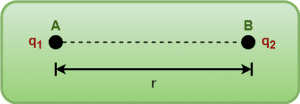
To calculate the electric potential energy of this system, we bring each of these from infinity one by one and calculate the work done in the process.
Step-01:
- We bring charge q1 from infinity to point A.
- It takes no work to bring the first charge because there is no field yet to work against.
∴ W1 = 0
Step-02:
- Now, we bring charge q2 from infinity to point B.
- The work done in bringing charge q2 from infinity to point B is given by-

The total work done in forming a two-charge system is given by-
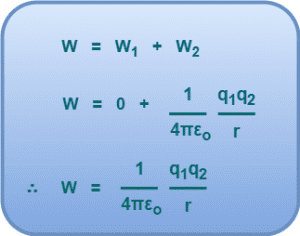
This work is stored in the form of electric potential energy of the system of two charges.
Thus, the electric potential energy of a system of two charges is given by-

Electric Potential Energy of a System of Three Point Charges-
Consider a system of three point charges as shown-
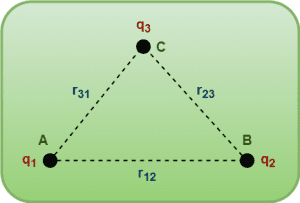
To calculate the electric potential energy of this system, we bring each of these from infinity one by one and calculate the work done in the process.
Step-01:
- We bring charge q1 from infinity to point A.
- It takes no work to bring the first charge because there is no field yet to work against.
∴ W1 = 0
Step-02:
- Now, we bring charge q2 from infinity to point B.
- The work done in bringing charge q2 from infinity to point B is given by-

Step-03:
- Now, we bring charge q3 from infinity to point C.
- The work done in bringing charge q3 from infinity to point C is given by-
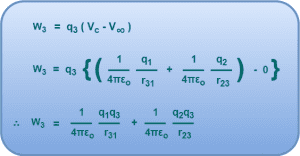
The total work done in forming a three-charge system is given by-
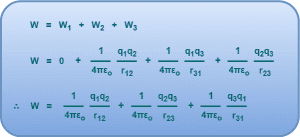
This work is stored in the form of electric potential energy of the system of three charges.
Thus, the electric potential energy of a system of three charges is given by-

Important Notes-
Note-01:
For two like charges,
- The potential energy of two like charges is positive.
- As the electrostatic force is repulsive, so a positive amount of work has to be done against this force to bring the charges from infinity to a finite separation.
For two unlike charges,
- The potential energy of two unlike charges is negative.
- As the electrostatic force is attractive, so a negative amount of work has to be done against this force to bring the charges from infinity to a finite separation.
Note-02:
While calculating the electric potential energy for a given system of charges using the above derived formulae, always put the value of charges with their proper signs.
Note-03:
To write the formula for electric potential energy of a system of any given number of charges,
- Just count the number of different pairs of charges (Number of pairs = nC2)
- Write the electric potential energy for each pair of charge
- Add the electric potential energy for each pair
Note-04:
Work done in dissociating a system of given charges is negative of the electric potential energy of the system of charges.
Read the next article on-
Potential Energy of Electric Dipole in Electric Field
Get more notes & other study material of the Chapter Electrostatic Potential & Capacitance.

